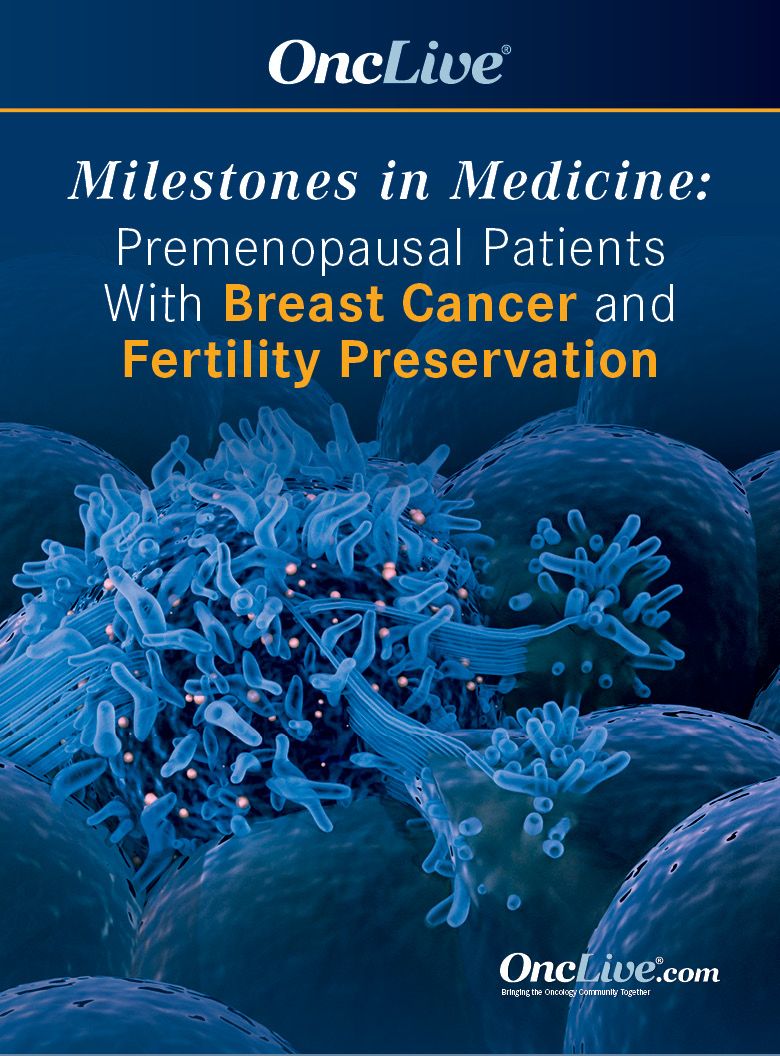Ovarian Suppression with GnRH Agonists Can Aid Fertility Preservation in Breast Cancer
Treatment regimens that include ovarian suppression with a gonadotropin-releasing hormone agonist have gained momentum in recent years as a potential solution to address treatment-related early menopause for women with breast cancer.
Kathryn Ruddy, MD

Women with breast cancer often experience premature menopause as a long-term adverse effect (AE) of treatment with chemotherapy.1 However, treatment regimens that include ovarian suppression with a gonadotropin-releasing hormone (GnRH) agonist have gained momentum in recent years as a potential solution to address treatment-related early menopause.
“A woman who initially [receives a] diagnosis [of breast cancer] while premenopausal who undergoes chemotherapy will come out of that chemotherapy with ovaries that are not as highly functioning as they were before,” Kathryn Ruddy, MD, a consultant in the Division of Medical Oncology, Department of Oncology, at the Mayo Clinic in Rochester, Minnesota, said in an interview with OncologyLive®. “For some patients, that means they go into an immediate menopause during chemotherapy. For others, it may mean that they do not go into menopause, but their ovarian function and their fertility will not be the same as it [was before]. They also often will go through menopause earlier than they would have otherwise for this because of this ovarian toxicity.”
The American Society of Clinical Oncology (ASCO) guidelines for fertility preservation in patients with cancer recommend oncologists discuss the possibility of infertility as soon as possible before commencing treatment. The guidelines cite embryo cryopreservation, cryopreservation of unfertilized oocytes, ovarian transposition, and conservative gynecologic surgery as proven methods for fertility preservation.2
The ASCO guidelines include recommendations for ovarian suppression with a GnRH agonist or other agent for fertility preservation when proven methods are not feasible. Ovarian suppression was cited as an option for young women with breast cancer to reduce the incidence of ovarian insufficiency caused by chemotherapy toxicity.2
“The field of fertility preservation is fairly new when we think about [it, arising within the past] 1 or 2 decades, but has really taken off,” Zaraq Khan, MBBS, a reproductive endocrinologist in the Department of Obstetrics and Gynecology at the Mayo Clinic, said in an interview with OncologyLive®. “We look at the gold standard being egg or embryo freezing. Embryo freezing is considered a little bit better than egg freezing because when we thaw embryos, they thaw better than an egg. [There is also] ovarian tissue freezing, [which] has been going on in Europe for quite some time and has now become clinical practice in the US as well.”
The Role of GnRH Agonists in Premenopausal Breast Cancer
GnRH agonists function by downregulating GnRH receptors in the pituitary gland which suppresses the release of luteinising hormone and follicle-stimulating hormone (FSH). The suppression of these hormones reduces the production of oestradiol in the ovaries.3
“The goal is to reduce estrogen when you are treating patients with breast cancer for hormone sensitive breast cancer,” Ann H. Partridge, MD, MPH, said in an interview with OncologyLive®. “When you are trying to preserve ovarian function, the goal is to stop ovulation. If you stop ovulation, the theoretical belief is that [using a GnRH agonist] you put the ovaries to sleep, so to speak. Therefore, there may be [reduction in the] effect of the chemotherapy on sleeping ovaries than there would have been on active, cycling ovaries through chemotherapy.”
Partridge is the vice chair of medical oncology, founder and director of the Program for Young Adults with Breast Cancer, and the director of the Adult Survivorship Program at Dana-Farber Cancer Institute in Boston, Massachusetts.
GnRH agonists have been evaluated for efficacy and safety in patients with breast cancer in several trials, however the only trial to date that reported number of pregnancies as a preplanned end point was the phase 3 POEMS trial (NCT00068601).1
Results from the POEMS trial showed that premonpausal patients with breast cancer treated with the GnRH agonist goserelin (Zoladex) plus chemotherapy (n = 105) experienced a 70% reduction in ovarian failure at 2 years on study vs those who received chemotherapy alone (n = 113). Additionally, the 5-year cumulative incidence of pregnancy was 23.1% (95% CI, 15.3%-31.9%) compared with 12.2% (95% CI, 6.8%-19.2%), respectively (P = .04).1
Updated survival findings also favored treatment with goserelin plus chemotherapy; the 5-year overall survival (OS) with the combination was 91.7% (95% CI, 84.0% -95.8%) compared with 83.1% (95% CI, 74.4%-89.0%) with chemotherapy alone. The adjusted hazard ratio for disease-free survival (DFS) was 0.72 (95% CI, 0.39-1.32; P = .29) and 0.46 (95% CI, 0.22-0.99; P = .05) for OS.
The primary end point of the trial was the rate of ovarian failure and FSH levels in the postmenopausal range at 2 years. Ovarian failure was defined as amenorrhea for the preceding 6 months. Secondary end points included pregnancy within 5 years and ovarian dysfunction, defined as amenorrhea for the preceding 3 months and FSH, estradiol, or inhibin B levels in the postmenopausal range.4
The median age for patients treated with the combination was 38 years (range, 25-49) vs 37 years (range, 26-48) for patients who received chemotherapy alone. The median follow-up time was 5.07 months (range, 0.44-10.89) and 5.04 months (range, 0.13-11.1), respectively.1
In terms of safety, previously reported findings found that the combination of goserelin plus chemotherapy was found to be well tolerated. Among 103 patients evaluable for safety, common grade 2 AEs included hot flashes (n = 29), headaches (n = 12), vaginal dryness (n = 12), and sweating (n = 7). Grade 3 hot flashes occurred in 4 patients and the only grade 4 AE was 1 instance of thromboembolism.4
Comparatively in the safety-evaluable chemotherapy arm (n = 111), common AEs included hot flashes (n = 14), vaginal dryness (n = 9), and sweating (n = 7). Grade 3 AEs consisted of hot flashes (n = 3), agitation (n = 1), joint paint (n = 1), and headache (n = 1). No grade 4 AEs were reported.
Additional results from other clinical trials have shown that ovarian suppression therapy in combination with other treatment modalities led to survival benefits and a decreased risk of recurrence among premenopausal patients with breast cancer. Combined data from the phase 3 SOFT (NCT00066690) and TEXT (NCT00066703) trials evaluated the long-term benefits of ovarian suppression in patients with hormone receptor–positive breast cancer.
The TEXT trial randomly assigned women within 12 weeks of surgery to 5 years to receive adjuvant treatment with the aromatase inhibitor exemestane (Aromasin) plus ovarian function suppression via the GnRH agonist triptorelin (Trelstar) or tamoxifen plusovarian function suppression. Treatment with chemotherapy was optional and was administered concurrently with ovarian function suppression therapy.5
In SOFT, patients were randomized to be treated with either exemestane plus ovarian function suppression therapy via triptorelin or oophorectomy, tamoxifen plusovarian function suppression, or tamoxifen alone. Treatment was given within 12 weeks of surgery if no chemotherapy was planned, or within 8 months of completing neoadjuvant chemotherapy.5
The primary end point of the combined analysis was DFS. Secondary end points included invasive breast cancer-free interval (BCFI), OS, and distant recurrence-free interval (DRFI).
At the May 2021 data cutoff date, the 12-year DFS rate was 80.5% in the combined exemestane plus ovarian function suppression population (n = 2346) compared with 75.9% among the 2344 patients in the combined tamoxifen plusovarian function suppression arm (HR, 0.79; 95% CI, 0.70-0.90). There was also a 4.1% improvement in 12-year BCFI and a 1.8% improvement in 12-year DRFI in the exemestane plus ovarian function suppression population compared with tamoxifen plusovarian function suppression.5
Investigators also noted an emerging OS benefit for patients treated with exemestane plus ovarian function suppression compared with tamoxifen plusovarian function suppression among patients with HER2-negative disease who also were treated with chemotherapy in both trials. In SOFT, the 12-year OS rates were 84.4% and 81.1%, respectively. In TEXT, the 12-year OS rates were 86.8% and 83.5%, respectively.5
Determining which patients are suited for treatment with a GnRH agonist or other ovarian suppression treatment for the purpose of preserving fertility can be challenging as some debate still remains as far as precisely which patients this treatment is right for. More proven options such as embryo or unfertilized oocytes cryopreservation remain the preferred option in this field. However, factors such as cost, timing, and the need for a partner can limit the fertility preservation options for younger patients. For this patient population, ovarian suppression with a GnRH agonist may present a more accessible option and can still be used in addition to established fertility preservation measures.4
“Reproductive endocrinologists really make the ultimate decision about what the best strategy for fertility preservation is for any individual,” Ruddy said. “Again, the gold standard for almost [every patient] would be egg harvesting and freezing, but that is not always feasible for all women. Some women decide to receive GnRH agonists in addition to egg harvesting. So they are not necessarily mutually exclusive. There are probably more women using GnRH agonists in the setting of hormonally insensitive tumors, although I cannot say that I have seen data on that. I would defer to reproductive endocrinology and the preferences of an individual patient.”
References
- Moore HCF, Unger JM, Phillips KA, et al. Final analysis of the prevention of early menopause study (POEMS)/SWOG intergroup S0230. J Natl Cancer Inst. 2019;111(2):210-213. doi:10.1093/jnci/djy185
- Oktay K, Harvey BE, Partridge AH, et al. Fertility Preservation in Patients with Cancer. J Clin Oncol. Published online April 5, 2018. doi:10.1200/JCO.2018.78.1914
- Robertson JFR, Blamey RW. The use of gonadotrophin-releasing hormone (GnRH) agonists in early and advanced breast cancer in pre- and perimenopausal women. Eur J Cancer. 2003;39(7):861-869. doi:10.1016/s0959-8049(02)00810-9
- Moore CF, Unger JM, Phillips KA, et al; POEMS/S0230 Investigators. Goserelin for ovarian protection during breast-cancer adjuvant chemotherapy.N Engl J Med. 2015; 372(10):923-932. doi:10.1056/NEJMoa1413204
- Regan MM, Walley BA, Fleming GF, et al. Randomized comparison of adjuvant aromatase inhibitor exemestane (E) plus ovarian function suppression (OFS) vs tamoxifen (T) plus OFS in premenopausal women with hormone receptor-positive (HR+) early breast cancer (BC): update of the combined TEXT and SOFT trials. Clin Cancer Res. 2022;82(suppl 4):GS2-05. doi:10.1158/1538-7445.SABCS21-GS2-05




